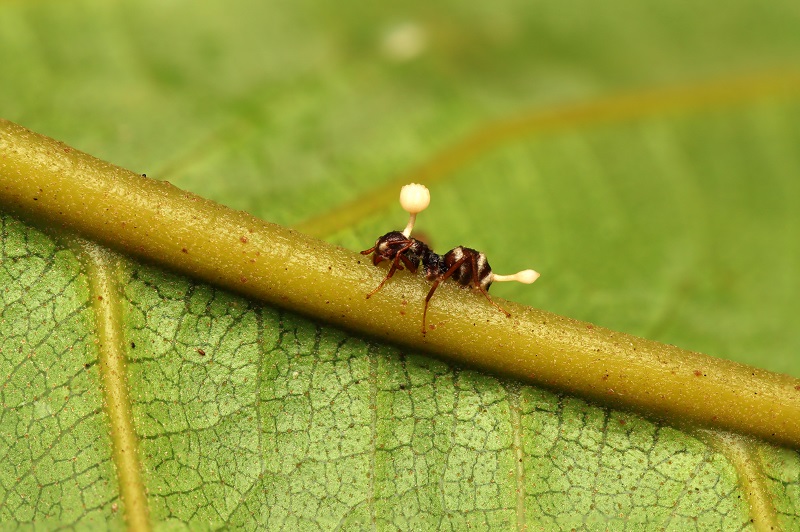Zombie Fungus From 'The Last of Us': Is It Real?

February 16, 2023
If you’ve been watching The Last of Us recently, or any other popular zombie apocalypse movie or TV show, you’re probably wondering if this could really happen.
Our expert, David Perlin, Ph.D., chief scientific officer at Hackensack Meridian Health’s Center for Discovery and Innovation (CDI), dives into the scientific background of the “zombie fungus” and if it's really dangerous.
Yes. The Last of Us Fungus is Real.
The fungus from The Last of Us is based on a real fungus that exists in nature today and is called Ophiocordyceps unilateralis, or cordyceps. Cordyceps is often referred to as the “zombie-ant fungus” because it primarily infects ants and other insects such as spiders.
Is the zombie fungus dangerous to humans?
The zombie fungus is not capable of infecting humans. It is actually common in some health supplements and in Chinese herbal medicine as it can improve immunity and possibly be helpful in fighting cancer cells or shrinking tumor size. Other potential health benefits include athletic performance improvements with stamina and strength, and better kidney function.
Humans cannot carry the fungus or be infected by it in any way due to the high internal temperatures of the human body. Human bodies are also much more complex than those of ants and other insects, which protects them from cordyceps infection.
What does the zombie fungus do?
Like in most zombie thrillers, the fungus is using “mind-control” to get the insect to do what it wants, essentially, making the bugs “zombies”.
- The goal of the fungus is to get their host to migrate to a climate most hospitable for the fungus to thrive and grow, typically humid locations.
- The fungus will drain the host of all nutrients and then fill the host’s body with spores that will allow for it to reproduce.
- It will then compel the host to seek higher ground and remain there before it expels the spores into the atmosphere.
Infection to other insects is primarily airborne, despite it being transferred through bites in The Last of Us. Another misconception from the show is that all those infected are connected, however, insects that are infected with cordyceps are not connected to one another in real life.
The ant, or any other insect host, will slowly be consumed by the fungus while sending out its own spores. Zombified ants can be found hanging from leaves or other plants during this stage and after the fungus has fully consumed them.
Are there any fungi that can affect humans?
Approximately one billion people suffer from hair, skin or nail infections, such as ringworm or Athlete’s foot, annually. There are other species of fungi that can affect a human’s mental state, such as psilocybin, better known as “magic mushrooms.” Overall, scientists know of approximately 150,000 species of fungi, but estimate a few million more to be discovered. Of this number, only about 200 can affect humans.
Fungal infections do carry serious health risks, especially for those who have weakened immune systems.
“An estimated 1.5 million people globally are killed by fungal infections. Among those on the World Health Organization's list of ‘priority pathogens’ is Candida auris, a multidrug resistant fungus discovered in 2009 but which is now common in healthcare settings in New York, New Jersey, Illinois, Florida, California, and has caused recent outbreaks in Nevada and Mississippi, among other places,” adds Dr. Perlin.
AIDS-related organisms like Cryptococcus neoformans kill hundreds of thousands of people annually frequently causing meningitis that can cause cognitive dysfunction.
Environmental fungi, like molds, spread by emitting free-floating spores in the air while some spread in the water and food supply, while a few can spread from person to person. Overall, they are slower to transmit than viruses.
“Nevertheless, two highly drug resistant organisms, Candida auris and Aspergillus fumigatus, have spread widely and are now global threats according to the CDC,” says Dr. Perlin. “The good news is that the human immune system, as well as the availability of anti-fungal treatments, are highly effective at controlling potential disease and limit the impact of most invasive fungal species.”
According to Dr. Perlin, “The properties that allow The Last of Us fungus, cordyceps, to attack insects in the way they do is very specific to the insect, and cannot be easily changed to affect other species, such as humans.”
Next Steps & Resources:
- Our source: David Perlin, Ph.D.
- To make an appointment with a physician near you, call 800-822-8905 or visit our website.
The material provided through HealthU is intended to be used as general information only and should not replace the advice of your physician. Always consult your physician for individual care.






